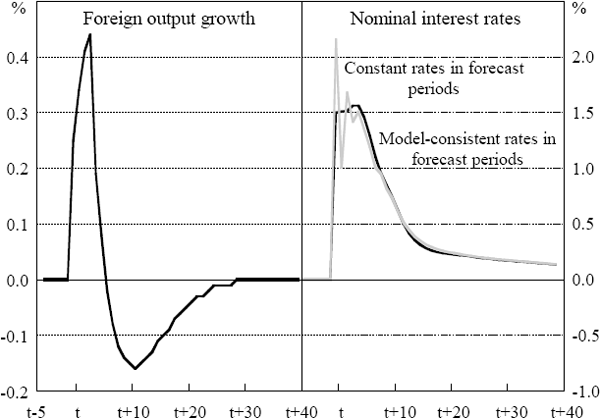RDP 9803: Forward-Looking Behaviour and Credibility: Some Evidence and Implications for Policy Appendix C: The Effect of Different Interest Rate Assumptions
February 1998
- Download the Paper 344KB
This appendix sets out an example to show the effect on the variability of interest rates of different interest rate assumptions in forward-looking monetary policy rules. Figure C1 shows the effect of an anticipated 1 per cent shock to foreign output spread out over one year (as deviations from baseline). The left-hand side panel shows the shock itself, with foreign output rising over four quarters, and then easing back to its equilibrium value, as determined by Equation (B1.7) in Appendix B.1.

The right-hand panel shows how nominal interest rates respond to this shock when policy-makers use a Taylor-type rule, responding to inflation and output forecasts four periods ahead, with a coefficient of 3 on the inflation forecast deviation and a coefficient of 1 on the output gap forecast. The shock is assumed to be anticipated, but the story is substantively the same if the shock is unanticipated. The grey line is the interest rate profile when the forecasts of inflation and output are generated assuming a constant nominal rate, and the black line is the profile when the policy-makers are assumed to use the Taylor-type rule in the forecast periods.
Forecasts are clearly less volatile and oscillatory in the model-consistent rate regime than in the constant rate regime. If the forecasts assume constant nominal interest rates, they do not take into account the policy response of policy to the shock, and so the initial policy response implied by the rule is larger than it needs to be. In the next period, policy has to correct the over-reaction. At higher reaction weights, these oscillations can become explosive.
If policy-makers are assumed to keep real, rather than nominal, interest rates constant in the forecast period, the results are very similar to the constant nominal interest rate outcome. This is because the shock assessed in this case is a real shock. When there is a nominal shock, such as an inflation shock, the system is considerably more variable when the nominal interest rate is kept constant than when the real rate is.